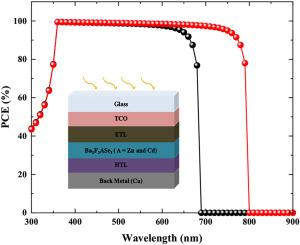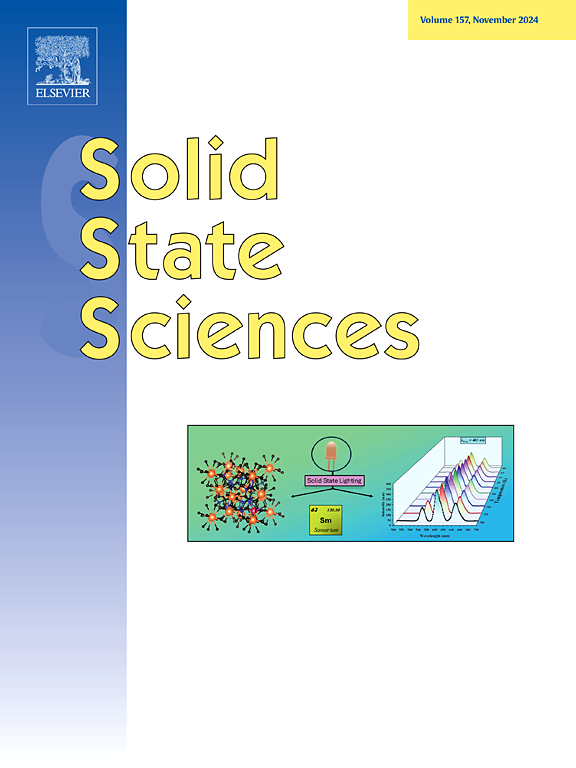Structural and optoelectronic properties of Ba3F2ASe3 (A = Zn and Cd) barium fluoro-selenides for energy storage application: In accordance with the Shockley–Queisser limit
IF 3.3
3区 化学
Q2 CHEMISTRY, INORGANIC & NUCLEAR
引用次数: 0
Abstract
Electronic structure, optical and Solar cell aspects of Barium fluoro-selenides Ba3F2ZnSe3 and Ba3F2CdSe3 in orthorhombic phase are studied using density functional theory. Structural parameters show accordance with the experimental outcomes. Electronic properties demonstrate that these compounds are semiconductors, active in the visible light spectrum, with bandgap values of 1.80 and 1.67 eV respectively. Additionally, electrical conductivity also provides evidence regarding the semiconducting properties of these compounds. In these compounds the substitution of Cd for Zn results in reduction of bandgap due to increasing atomic size. The optically dynamic nature of these compounds in the visible region make them paramount applicants for optoelectronic devices and are dynamic aspirants for solar cell applications. These compounds-based solar cell device is modeled which shows best performance when using Ws2 as the ETL, MoO3 as the HTL [TCO/(IGZO)(SnO2)/Ba3F2ASe3(A = Zn and Cd)/(Cu2O)(V2O5)/Cu], With Jsc values of 18.34 and 25.62 mA/cm2, Voc values of 1.29 and 1.49 V, FF values of 90.03 and 91.33 % and PCE values of 25.08 and 29.82 %, respectively shown by the optimized solar cells devices. Because of their inorganic nature and their ability to enhance photovoltaic performance, this finding opens the way for the experimental development of fluoro-selenides.

用于储能应用的Ba3F2ASe3 (A = Zn和Cd)氟硒化钡的结构和光电性能:符合Shockley-Queisser极限
利用密度泛函理论研究了正交相氟硒化钡Ba3F2ZnSe3和Ba3F2CdSe3的电子结构、光学和太阳能电池性能。结构参数与试验结果一致。电子性质表明,这些化合物是半导体,在可见光光谱中活跃,带隙值分别为1.80和1.67 eV。此外,电导率也为这些化合物的半导体特性提供了证据。在这些化合物中,以Cd取代Zn会由于原子尺寸的增大而导致带隙的减小。这些化合物在可见光区域的光学动态性质使它们成为光电器件的首要申请者,并且是太阳能电池应用的动态追求者。以Ws2为ETL, MoO3为HTL [TCO/(IGZO)(SnO2)/Ba3F2ASe3(A = Zn和Cd)/(Cu2O)(V2O5)/Cu]为模型,优化后的太阳能电池器件Jsc值分别为18.34和25.62 mA/cm2, Voc值分别为1.29和1.49 V, FF值分别为90.03和91.33%,PCE值分别为25.08和29.82%。由于它们的无机性质和增强光伏性能的能力,这一发现为氟硒化物的实验开发开辟了道路。
本文章由计算机程序翻译,如有差异,请以英文原文为准。
求助全文
约1分钟内获得全文
求助全文
来源期刊

Solid State Sciences
化学-无机化学与核化学
CiteScore
6.60
自引率
2.90%
发文量
214
审稿时长
27 days
期刊介绍:
Solid State Sciences is the journal for researchers from the broad solid state chemistry and physics community. It publishes key articles on all aspects of solid state synthesis, structure-property relationships, theory and functionalities, in relation with experiments.
Key topics for stand-alone papers and special issues:
-Novel ways of synthesis, inorganic functional materials, including porous and glassy materials, hybrid organic-inorganic compounds and nanomaterials
-Physical properties, emphasizing but not limited to the electrical, magnetical and optical features
-Materials related to information technology and energy and environmental sciences.
The journal publishes feature articles from experts in the field upon invitation.
Solid State Sciences - your gateway to energy-related materials.
 求助内容:
求助内容: 应助结果提醒方式:
应助结果提醒方式:


